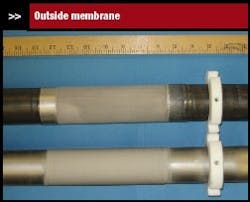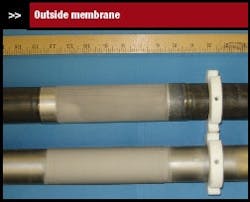The door opens for inorganic membranes
Zeolites and other inorganic-based thinfilm gas-separation membranes suffer from a perception problem, says Richard D. Noble, a professor in the chemical and biological engineering department of the University of Colorado, Boulder, Colo. The technical community generally believes “this is a research technology that has far too many problems and issues to be commercially successful,” he notes. However, Noble maintains, “Commercialization is closer than people think.”
Other academics agree. Commercialization will come in three to five years, predicts Yi Hua Ma, professor of chemical engineering at Worcester Polytechnic Institute, Worcester, Mass. That timeline also seems accurate to William J. Koros, professor of chemical engineering at the Georgia Institute of Technology’s School of Biochemical and Chemical Engineering, Atlanta.
Given such forecasts, it’s timely to look at membrane developments. Advances extend beyond zeolites to inorganic membranes such as palladium (Pd) and its alloys and mixed-matrix membranes such as zeolite-polymerics.
Potential benefits
One major attraction of the approximately 40 natural and more than 150 synthetic zeolites is their potential use in challenging environments that polymeric materials can’t survive. That means temperatures from approximately 120°C to more than 400°C, “typical reaction temperatures for petrochemicals,” notes Michael Tsapatsis, a professor in the chemical engineering and materials science department at the University of Minnesota, Minneapolis-St. Paul, Minn. “Because many reactions take place at high temperature, this is where most of the development is aiming.” The materials also function at pressures of 10 to 100 atmospheres, he adds.
Another feature of zeolites is their small pore sizes, typically less than 1 nm, and narrow pore-size distribution, adds Noble, who also serves as co-director of the National Science Foundation’s Center for Membrane Applied Science & Technology.
Zeolites’ properties can be tailored to get membranes for separation of different groups of gases and liquids, explains Jerry Y. S. Lin, professor of chemical engineering and director of the Materials for Separations Laboratory at Arizona State University, Tempe, Ariz. He calls zeolites the “hottest, most promising material” he’s examining now. “We need to improve performance and reduce cost. Then, we’ll find more applications,” emphasizes Lin, who works with “almost every inorganic chemical” and draws support from BP, Honda America, NGK and other firms.
Membrane performance for separation of gases needs improvement in two areas, Lin says. One is temperature. “For example, [for] a gas mixture of CO2 over nitrogen, at low temperatures — between 100°C and room temperature — separation is OK. But at higher temperatures, performance decreases because efficiency is mixture-specific,” he notes. The other area is the number of non-zeolite pores in a membrane, which needs cutting to reduce selectivity interference, he adds.
The cost issue
Cost remains a major hurdle to commercialization. Zeolites/ inorganic membranes generally are “a lot more expensive than polymers,” notes Lin. “I think if you can produce a zeolite membrane at $1,000 per square meter, that’ll be [competitive],” he believes. Cost, of course, depends upon materials; metals such as palladium may be more expensive. “I would expect that within five to 10 years these issues will have been resolved — or at least improved,” he adds.
Developing manufacturing methods to create economical devices having minimal defects is critically important for producing commercially successful large-scale membrane systems, Koros stresses. With mass production, costs will come down, agrees Ma, who directs Worcester Polytechnic’s Center for Inorganic Membranes Studies.
Ma, with support from Shell over the past six or seven years, has been studying palladium alloys for hydrogen separation/production because pure palladium becomes brittle in the process. That occurs because up-and-down temperature swings cause constant expansion/contraction of the metal’s crystalline lattice.
Optimal alloy mixtures exist. It’s approximately 60-40 for Pd-Cu. “With gold, at about 5%-to-20% alloy, you get about 200% more hydrogen permeability than with just palladium,” Ma notes. A 23% silver alloy gives about 70% more hydrogen permeability compared to a pure Pd membrane, he adds.
Figure 1. Hydrogen diffuses through membrane and porous stainless steel support tube to its annular space. Source: Worcester Polytechnic.
Meanwhile, John Falconer, chair of Colorado’s chemical and biological engineering department, has shown that absorbed molecules can improve the performance of the zeolites such as MFI, whose pore size approximates the size of many organic molecules. “Recently, we’ve found that when zeolites absorb certain molecules in the pores, that makes the zeolite crystals swell.” This shrinks the pore size, dramatically raising selectivity. “We think it’s a big find,” he says. “If you look at branched C6s, a molecule that only goes through the defects — such as 2,2-dimethylbutane [C6H14] — is too large to go through the zeolites at significant rate.” However, by adding 1% to 2% of hexane to the gas, “we see the flux decrease through the defects by one to two orders of magnitude for some membranes.”
A lower cost option
However, some see costs remaining prohibitive for membranes made from pure inorganics and metallics. “They have good performance, but they cost about 500 to 1,000 more times per square meter [than polymerics],” says Koros, who also is editor-in-chief of the Journal of Membrane Science. “The problem [potential end-users say] is: ‘They have high performance, but if it’s so expensive, I can’t do that.’” He suggests the solution is obvious: “Get production that’s less expensive. But you can’t do that if there’s no demand.”
The potential demand certainly exists. Commercial plants would require thousands of square meters, notes Tsapatis, who’s currently collaborating with Pall Corp. as well as Koros. But Tsapatsis asks, “Who’s going to make those thousands of square meters? And how?” Those are the primary obstacles now, he believes. Techniques used in the laboratory don’t suit largescale production, he notes.
Mixed-matrix membranes, which combine zeolites with polymers, promise to address both production and cost issues, hopes Koros. He and his colleagues focus on hollow-fiber membranes. This should allow using the production technology for hollow-fiber membranes, he believes. “Hollow fibers are spun like textile fibers. The same spinning machines could be used for zeolite-polymeric membranes,” he explains.
His group aims to marry the performance of the zeolite and the cost of the polymer. “You can’t get performance of zeolite with the cost of polymer — but you can get close,” Koros notes. How near depends on selectivity, which is very significant to process efficiency, he says. “You might be able to get as close as a factor of two.”
Mixed-matrix membranes still must overcome “very serious obstacles,” he admits. The biggest is building new membranes around old technology. “Do that and thermal separation problems arise.”
The mixed-matrix product represents a practical plat-form, Koros emphasizes. It can be implemented relatively quickly and provides, at lower cost, many of the advan-tages of pure inorganic membranes, he says. However, it’ll be three to five more years before commercial production of zeolite-polymeric membranes begins, he predicts.
Some companies certainly see the potential. Chevron, for instance, has been working with Koros since the mid-1990s on membranes for natural gas purification and oth-er uses, notes Steve Miller, senior consulting scientist with Chevron Energy Technology Co., Richmond, Calif. “The membranes we have been investigating have been primar-ily composites of zeolites or carbon molecular sieves within a polymer matrix, where the zeolite or sieve enhances the separation properties of the membrane beyond that of the polymer alone.”
While Miller didn’t reveal when commercialization will begin, he says this is “a promising approach for en-hancing the performance of polymer membranes.” It can help make membrane separation more competitive with alternative technologies for some separations, he believes.
(Polymer membranes are advancing in their own right, too. For example, as CP reported in November, polymer membranes with hour-glass-shaped pores reportedly provide significantly better performance for gas sepa-ration than do conventional membranes. The first industrial trial should occur within five years in Korea for CO2 re-moval from power-plant stack gas.)
Bold action needed
Now squarely on the commercialization path is collabora-tive research by Noble and Falconer. With support from Shell for the past four to five years, they’ve investigated SAPO-34 zeolite membranes to remove carbon dioxide from natural gas. “We have been able to improve produc-tivity — a technical term for permeance, the flux across the membrane divided by the driving force, which is the delta P [pressure] — by a factor of 10, while maintaining the selectivity at or near 100,” Noble says, noting that se-lectivity here means the ratio of CO2 permeance to meth-ane permeance. “That means less membrane is needed,” he adds. And, because of that finding, “Shell has indicated that they’re pursuing commercialization.”
Like Koros’ best guess for zeolite polymerics, Noble reckons it will be three to five years before industrial availability. “This would be the first commercial production and application of a gas-separation zeolite membrane,” he be-lieves. “[It] will make a big splash,” Noble hopes, because current polymeric gas-separation membranes are mature technology. For real progress, he says, “it’s going to have to be the introduction of new materials where the traditional polymeric membranes don’t work… [And] if this becomes commercial, then that gets people’s attention — and that means that economics and science are viable.”
However, getting gas-separation membranes to market will require cost-effective technology as well as indus-trial boldness, Koros suggests. He predicts “tremendous” growth in use of gas-separation membranes if membranes’ selectivity can be enhanced “especially in high-gas-volume areas of natural-gas sweetening and low-purity nitrogen production.” The key, he believes, will be “having people willing to take enough of a step, to say, ‘We’re going to try to ‘use membranes.’”

